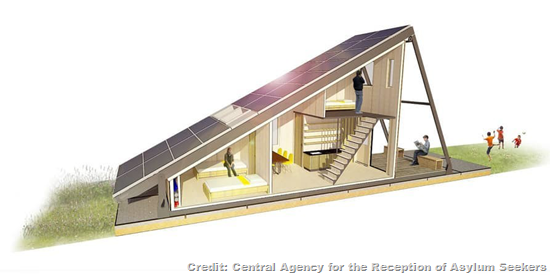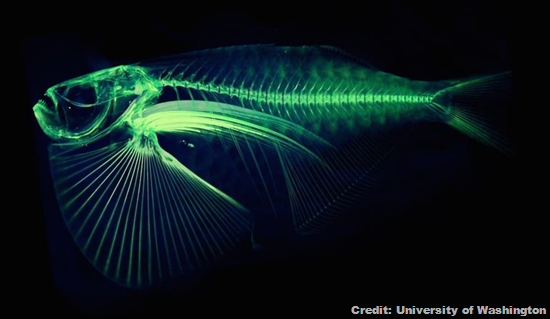An electric speedboat, a levitating clock and a flying hotel round out this week's gallery.
1. Proposed Olympic Bridge
A proposal for a bridge in Beijing for the 2022 Winter Olympic games takes inspiration from the iconic Olympic rings. Designed by architecture studio Penda, the Olympic bridge would span the Gui River and create a new transportation route between Beijing and Zhangjiakou, a district to the northwest, where outdoor competitions will be held.
2. Flying Hotel Pods
Architecture firm HOK has a radical new idea for hotels and tourism. They propose individual flying hotel pods that would transport tourists to just about any destination, where building a hotel is not feasible or could bespoil the environment. The pods contain all necessary amenities for sleeping, showering, and eating. They can also be linked together to create an oasis for larger groups travelling together.
3. Electric Speedboat
Electric speedboats could be the best of both worlds, combining the thrill of fast cruising with the quiet of sailing. Dutch company Edorado Marine is working on their all-electric Edorado 7S, designed to travel at 40 knots with a range of about 50 miles.
4. Motion Sensing Walls
Credit: ESI Design via Vimeo
If you’re in Washington, D.C. in the near future, step inside Terrell Place at the corner of 7th and F Streets to experience the interactive media installation from ESI Design. The firm integrated floor-to-ceiling displays on several walls in public areas and then set up 14 infrared cameras in several lobbies and corridors. The cameras sense motion and then project graphics that swoon according to the activity.
5. Solar-Powered Drone
This week, Facebook’s Connectivity Lab conducted the first full-scale test flights of its high-altitude unmanned drone, the Aquila, which is part of the company’s long-term goal to bring internet access to hundreds of millions of people living in remote places.
6. Golf Cart Jetpack
Back in 2013, pro golfer Bubba Watson (above) teamed up with Oakley and Neoteric Hovercraft to create the Golf Cart Hovercraft. As a follow-up, they worked with Martin Aircraft and this week presented the Golf Cart Jetpack, which flies up to 3,000 feet high and travels as fast as 46 mph.
7. Solar-Powered Refugee Shelter
At the “A Home Away from Home” competition in the Netherlands, participants were tasked with designing temporary housing for people seeking asylum. The SolarCabin, from a team at dNArchitectuur, was one of six winners. Thanks to an uncomplicated modular design, the home can be built in one day and the sloping roof covered in solar panels helps generate 4,800 kWh of electricity per year.
8. Levitating Clock
Nixie tubes - which resemble vacuum tubes but do not depend on the heat-induced flow of charged particles - have seen their day come and go. These gas-filled glass tubes, invented in the mid-1950s, were typically used as numerical counter displays. Now, Scottish electronics developer Tony Adams wants to repurpose them as magnetically levitating clocks. His Kickstarter campaign, which has 26 days to go, is aimed at funding these unusual clocks, which do not require batteries. According to the site, “The nixie clock is powered from the base without wires and will operate without interruption for months or years. No charging is required, it just floats and works.” You can see the video of the clock here.
9. World’s Most Efficient Electric Car
A team of engineers from the Technical University of Munich recently achieved the Guinness World Record for the most efficient electric vehicle. TUfast Eco Team’s TUfast eLi14 officially got 765.53 mi/kWh, which is equivalent to 26,135 US mpg and would theoretically allow the car to cover 6,808 miles on one litre of gas.
10. 3-D Scans of Every Species
Using a CT scanner, University of Washington’s Adam Summers is embarking on an ambitious project. He wants to create high-resolution 3-D models of skeletons of every known species of fish. The images will be uploaded to the Open Science Framework, making them available to anyone for viewing and downloading. Once all 25,000 known fish species are uploaded, Summers will then begin scanning the 50,000 known vertebrate species.









No comments:
Post a Comment
Please adhere to proper blog etiquette when posting your comments. This blog owner will exercise his absolution discretion in allowing or rejecting any comments that are deemed seditious, defamatory, libelous, racist, vulgar, insulting, and other remarks that exhibit similar characteristics. If you insist on using anonymous comments, please write your name or other IDs at the end of your message.